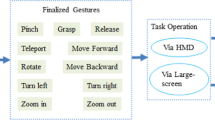Abstract
Virtual hands play key roles in three-dimensional interaction in various virtual reality applications. However, their visual realism has seldom been seriously discussed in the community of human computer interaction, not to mention the challenging balance between their visual/motion realism and real-time performance. In this paper, a novel approach for virtual hand interaction modeling based on dual quaternion is proposed. Specifically, dual quaternion blending (DQB) is introduced as pseudo muscular layer of our virtual hand model instead of traditional linear blending (LB) and quaternion blending (QB) due to its advantages in muscular deformation. A framework for virtual hand interaction is proposed which supports both gesture interactions and 3D manipulations. Experimental results show that our proposed virtual hand interaction model is suitable for most virtual reality applications and achieves good visual/motion realism while maintains real-time performance.
Similar content being viewed by others
References
Han X, Wan H. A framework for virtual hand haptic interaction. In: Pan Z G, Cheok A D, Müller W, et al., eds. Transactions on Edutainment IV, LNCS Vol 6250. Berlin: Springer, 2010. 229–240
VirtualHand SDK/Studio. http://www.vrlogic.com/html/immersion/virtual_hand_sdk.html
Y. Yasumuro, Q. Chen, K. Chihara. Three-dimensional modeling of the human hand with motion constraints. Image Vis Comput, 1999, 17: 149–156
Zhao Q. A survey on virtual reality. Sci China Ser F-Inf Sci, 52: 348–400
Moccozet L, Thalmann N M. Dirichlet free-form deformations and their application to hand simulation. In: Proceedings of Computer Animation, Geneva, 1997. 93–102
Albrecht I, Haber J, Seidel H. Construction and animation of anatomically based human hand models. In: Proceedings of the 2003 ACM SIGGRAPH/Eurographics symposium on Computer Animation, San Diego, 2003. 98–109
Rhee T, Neumann U, Lewis J P. Human hand modeling from surface anatomy. In: Proceedings of the 2006 Symposium on Interactive 3D Graphics and Games. New York: ACM, 2006. 27–34
Yang S, Qi Y, Qin H. Simultaneous structure and geometry detail completion based on interactive user sketches. Sci China Inf Sci, 55: 1123–1137
Li Y. Data-driven grasp synthesis using shape matching and task-based pruning. IEEE Trans Vis Comput Graph, 2007, 13: 732–747
Ciocarlie M, Lackner C, Allen P. Soft finger model with adaptive contact geometry for grasping and manipulation tasks. Washington DC: IEEE Computer Society, 2007. 219-224
Wan H, Chen F, Han X. A 4-layer flexible virtual hand model for haptic interaction. In: Proceedings of International Conference on Virtual Environments, Human-Computer Interfaces and Measurements Systems (VECIMS), Hong Kong, 2009. 185–190
Jacob J, Froehlich B. A soft hand model for physically-based manipulation of virtual objects. In: Proceedings of IEEE Virtual Reality, Singapore, 2011. 11–18
Kavan L, Žára J. Spherical blend skinning: a real-time deformation of articulated models. In: Proceedings of Symposium on Interactive 3D Graphics and Games. New York: ACM, 2005. 9–16
Kavan L, Collins S, Žára J, et al. Skinning with dual quaternions. In: Proceedings of ACM SIGGRAPH Symposium on Interactive 3D Graphics and Games. New York: ACM, 2007. 39–46
Kavan L, Collins S, Žára J, et al. Geometric skinning with approximate dual quaternion blending. ACM Trans Graph, 2008, 27: 105
Sederberg T, Zheng J, Sewell D. Non-uniform recursive subdivision surfaces. In: Proceedings of SIGGRAPH98. New York: ACM, 1998. 387–394
Kapit W, Elson L. The Anatomy Coloring Book. 2nd ed. Harper Collins, 1993
Scalable Graphics/Geometric Algorithm Laboratory, Korea Advanced Institute of Science and Technology. OpenCCD: Continuous Collision Detection API. http://sglab.kaist.ac.kr/OpenCCD/
Kotelnikov A P. Screw calculus and some of its applications to geometry and mechanics (in Russian). Ann Imper Univ Kazan, 1895
Study E. Geometrie der Dynamen. Leipzig: Teubner, 1901
Pennestri E, Valentini P. Dual quaternions as a tool for rigid body motion analysis: a tutorial with an application to biomechanics. Arch Mech Eng, 2010, LVII: 187–205
Jüttler B. Visualization of moving objects using dual quaternion curves. Comput Graph, 1994, 18: 315–326
Chen H. A screw motion approach to uniqueness analysis of head-eye geometry. In: Proceedings of the IEEE Conference on Computer Vision and Pattern Recognition, 1991, Maui. 145–151
Schneiderman B, Plaisant C. Designing the User Interface: Strategies for Effective Human-Computer Interaction. 5th ed. Boston: Addison-Wesley, 2009
Author information
Authors and Affiliations
Corresponding author
Rights and permissions
About this article
Cite this article
Chen, W., Zhu, S., Wan, H. et al. Dual quaternion based virtual hand interaction modeling. Sci. China Inf. Sci. 56, 1–11 (2013). https://doi.org/10.1007/s11432-013-4815-8
Received:
Accepted:
Published:
Issue Date:
DOI: https://doi.org/10.1007/s11432-013-4815-8




